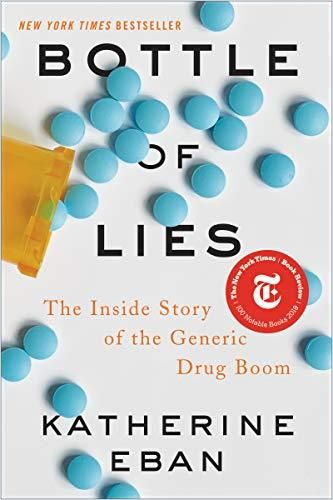Andrew Carnegie fellow Katherine Eban details the widespread corruption within the generic drug industry and explains why government regulators are all but powerless to protect consumers.

Dangerous Generics
Andrew Carnegie fellow Katherine Eban, a contributor to Fortune magazine, warns about the dangers of generic drugs. Spanning continents and decades, she depicts an industry rife with corruption and fraud – focusing, primarily, on the case of Ranbaxy Laboratories. Eban uses the Ranbaxy case to illustrate how regulatory bodies like the US Food and Drug Administration have failed to stop the industry’s malfeasance, and why she doesn’t think circumstances will improve. It is a necessary read, though a far from happy one.
Eban’s stellar journalism resulted in Bottle of Lies becoming a New York Times bestseller, and earned it a listing on the New York Times’s 100 Notable Books of 2019 and the New York Public Library Best Books of 2019. She garnered uniformly positive reviews for her writing and for the power of her insights. NPR.org called Eban’s work, “Propulsive…astounding…disturbing,” and The Hindustan Times wrote, “An extraordinary international corporate thriller… This book is good for your health.”
Companion readings on drug company corruption include Eban’s Dangerous Doses and China Rx by Rosemary Gibson.
A Mammoth Industry
Eban opens with a concise overview of the generic drug manufacturing industry, though the scale of the market might shock you: Generics, Eban reveals, now make up 90% of US drug inventory. She explains that when a brand-name drug’s patent expires, regulators such as the US Food and Drug Administration (FDA) allow manufacturers to formulate generic versions. Generics trim health care expenses for first-world patients as well as charitable organizations such as Doctors Without Borders.
Without [generics] every large-scale government health program – the Affordable Care Act, Medicare Part D, the Veterans Health Administration, charitable programs for Africa and the developing world – would be unaffordable.Katherine Eban
Eban raises one crucial point throughout the book: The enormity of the market breeds corruption and fraud. In the United States, the Food and Drug Administration (FDA) certifies the safety and efficacy of drugs, but it faces significant challenges certifying drugs manufactured overseas. By 2005, Eban discovered, the agency was struggling to monitor hundreds of plants in the United States, Europe, India and China.
“Bioequivalent”
Eban reports that, in the 1980s, after intense lobbying by the generic drug industry, policymakers not only created a process for FDA approval of generics, but also granted generic drug-makers a major shortcut to the market. Rather than having to submit their drugs to long-term trials, generics companies only had to show that their medications were the “bioequivalent and performed similarly in the body” to name-brand drugs. The FDA enforced the protocols of “current good manufacturing practices” but, Eban cautions, it could not stage surprise inspections in foreign countries.
Corruption
Eban depicts an industry rife with corner-cutting and moral gray areas. She recounts the first generic drug scandal in 1988 and explains that it exposed widespread corruption within the US drug industry. Drug company executives, Eban uncovered, regularly bribed FDA reviewers.
The House Energy and Commerce Committee learned that the FDA was barely monitoring the drug ingredients, known as bulk drugs, pouring in from overseas.Katherine Eban
The payoffs led to the 1992 US Generic Drug Enforcement Act, which tightened the application and review process and mandated “preapproval inspections.” But, the author laments, by the end of the 1990s, the FDA already couldn’t keep up with the inspection volume.
Ranbaxy Laboratories
To illustrate the terrifying – to consumers – fraud within the generic drug industry more fully, Eban dives deep into pharmaceutical manufacturer Ranbaxy. That company’s saga is noteworthy, not only because of the mind-blowing bottomlessness and cynicism of its corruption, but because, as Eban repeatedly underscores, Ranbaxy continues to profit by selling worthless or dangerous generics worldwide.
In 2001, Eban reports, Ranbaxy was India’s biggest drug company. Then, a World Health Organization (WHO) inspection exposed Ranbaxy’s AIDS drug test as a sham; AIDS drugs reached the market untested. Ranbaxy, Eban explains, fabricated drug dissolution information, substituted brand-name drugs for its products in tests and copied the results of brand-name drug tests into its applications.
The FDA cracked down on Ranbaxy with one hand and opened an escape hatch with the other.Katherine Eban
Eban discusses what, at first, appeared to be a win over Ranbaxy’s fraudulent tactics: In November 2009, federal prosecutors recounted the company’s violations, and, in 2010, they proposed a $3.2 billion settlement to Ranbaxy’s lawyers. However, Eban reveals, in the end, it was Ranbaxy that emerged victorious.
In 2002, Ranbaxy had applied to produce a generic version of Lipitor. The US government spent $2.5 billion, annually, on Lipitor, and senators wrote to the FDA claiming that a delay in producing a generic version would cost Americans up to $18 million, daily. Eban tells how, on November 30, 2011, the FDA granted Ranbaxy a six-month exclusive contract to produce generic Lipitor. As a result, Ranbaxy earned almost $600 million. The following year, it recalled millions of generic Lipitor pills after finding that some contained shards of glass.
Eban discloses, with no shortage of bitter irony, that Ranbaxy later agreed to pay $500 million – $100 million less than it earned from Lipitor – in “fines, forfeitures and penalties.”
A Harrowing Read
Eban is no stranger to the drug manufacturing world, as her earlier publication, Dangerous Doses, makes clear. She is both a crusader and a diligent truth-finder. As few authors can, she recounts arcane facts and bureaucratic battles in a manner which is both fascinating and tension-filled – keeping the reader eager to know more. Eban repeatedly explains what policy and policing measures might help combat drug-related fraud, if only some agency could undertake them. And she never loses sight of her main goal: warning consumers of the dangers they face when it comes to generic drugs and the actions they must take to protect themselves. This extraordinary work is valuable to laypeople, policymakers, physicians, druggists, students, consumer activists and anyone who ever takes a prescription medication. It reads like a thriller, but the unexpected victim of the corruption, Eban shows, is you.






